List of Mexican dishes
The Spanish conquest of the Aztec Empire occurred in the 16th century. The basic staples since then remain native foods such as corn, beans, squash and chili peppers, but the Europeans introduced a large number of other foods, the most important of which were meat from domesticated animals (beef, pork, chicken, goat and sheep), dairy products (especially cheese) and various herbs and spices, although key spices in Mexican cuisine are also native to Mesoamerica such as a large variety of chili peppers and cilantro.
Antojitos
Street food in Mexico, called antojitos is prepared by street vendors and at small traditional markets in Mexico. Most of them include corn as an ingredient.
- Aguachile
- Bolillos (salty bread)
- Burrito
- Camote (Mexican sweet potato)
- Cemitas sandwiches
- Chalupa
- Chapulines and escamoles
- Charales, small fish, basically a type of smelt
- Chicharrón
- Chilaquiles
- Chimichangas (Tex-Mex mostly)
- Choriqueso
- Chorizo

- Cochinita pibil
- Cocido
- Cóctel de camarón and other seafood cocktails
- Corunda
- Curtido
- Elote
- Enchilada (red or green)
- Enfrijoladas
- Ensalada de fruta (fruit salad)
- Entomatadas
- Fajitas
- Filete de pescado
- Flautas
- Frijoles charros
- Fritada
- Gorditas
- Gringas
- Huauzontles
- Huaraches
- Jicama
- Jocoque
- Lengua
- Lentil soup (lentil beans)
- Longaniza
- Machaca
- Mancha manteles
- Memela
- Menudo
- Mixiotes
- Mole de olla
- Mole poblano
- Molletes
- Molotes
- Moronga
- Nachos
- Pambazos
- Panucho
- Papadzules
- Parilladas
- Pastel azteca
- Pejelagarto
- Picadillo
- Quesadillas
- Queso
- Rajas con crema
- Romeritos
- Salbutes
- Salsa
- Sincronizadas
- Sopes
- Sopa de albondiga (meatball soup)
Cheese dishes
- Caldo de queso
- Queso de cuajo
- Queso flameado
Egg dishes
Meat dishes
Beef dishes
- Albóndigas, Mexican meatballs.
- Aporreadillo
- Bistec
- Carne asada, grilled beef
- Carne guisada, stewed beef in spiced gravy
- Carne a la tampiqueña, carne asada that is usually accompanied by a small portion of enchiladas (or chilaquiles), refried beans, fresh cheese, guacamole, and a vegetable (often rajas; grilled slices of Poblano peppers).
- Cecina – In Mexico, most cecina is of two kinds: sheets of marinated beef, and a pork cut that is pounded thin and coated with chili pepper (this type is called cecina enchilada or carne enchilada).[1]
- Milanesas – Chicken, beef, and a pork breaded fried bisteces.
Goat dishes
Pork dishes
Poultry dishes
- Pollo asado
- Pollo Encacahuatado
- Pollo motuleños
- Pollo picado
- Pollo rostizado
Other meat and protein dishes
- Ancas de Rana
- Barbacoa
- Birria – a spicy stew from the state of Jalisco traditionally made from goat meat or mutton
- Chapulines – toasted grasshoppers seasoned with salt and lime
- Pastel azteca
- Puntas
- Queso de Puerco, head cheese prepared with vinegar, garlic, oregano and black pepper, among others. Wheels are often sold covered in paraffin wax. Non dairy.
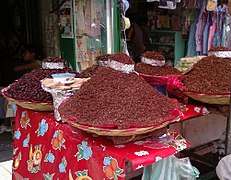 Chapulines – toasted grasshoppers
Chapulines – toasted grasshoppers
Moles, sauces, dips and spreads
- Chamoy
- Guacamole
- Mole blanco
- Mole sauce
- Mole verde
- Pipian – green or red, meat, pork
- Salsa
- Salsa chipotle
- Salsa verde
 Guacamole with tortilla chips
Guacamole with tortilla chips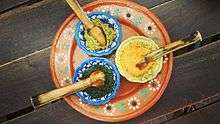 Habanero, chipotle and chimichurri salsas
Habanero, chipotle and chimichurri salsas
Rice dishes
- Arroz a la tumbada (rice with seafood)
- Arroz amarillo (yellow rice)
- Arroz con camarones (rice with shrimp)
- Arroz con huevo (rice with eggs)
- Arroz con leche
- Arroz con lima (rice with lemon)
- Arroz con pollo (rice with chicken)
- Arroz negro (black rice)
- Arroz poblano
- Arroz rojo (red rice, Mexican rice, or Spanish rice)
- Arroz verde (green rice)
- Morisqueta
Seafood dishes
- Aguachile
- Camarones al Mojo de Ajo
- Huachinango a la Veracruzana
- Huachinango a la Veracruzana (Veracruz-Style Red Snapper)
 Pescado zarandeado
Pescado zarandeado
Soups and stews
- Birria
- caldo de pollo, chicken soup
- caldo de res, beef soup
- caldo de queso, cheese soup
- caldo de camaron shrimp soup, typically made from dried shrimp
- carne en su jugo, meat and beans in a meat broth
- caldo de mariscos, seafood soup
- caldo tlalpeño, chicken, broth, chopped avocado, chile chipotle and fried tortilla strips or triangles - may include white cheese, vegetables, chickpeas, carrot, green beans
- Chilpachole de jaiba
- Fideos (noodles)
- Menudo
- Pozole
- Sopa, typically pasta flavored with meat or tomato consomme
- Sopa Azteca
- Sopa de fideo
- Sopa de lima, from Yucatán
- Sopa de nueces, walnut soup
- Sopa de pescado siete mares, a seven-fished bouillabaisse popular in the Gulf of California and Pacific areas
- Sopa de pollo (chicken soup)
- Sopa de tortilla (tortilla soup)
- Sopa tarasca
Vegetable dishes
- Chile relleno
- Chiles en nogada
- Cuitlacoche, a fungus that grows on corn plants, often served in soups
- Frijoles
- Frijoles pintos (pinto beans)
- Frijoles negros (black beans)
- Frijoles charros
- Frijoles refritos (refried beans)
- Nopalitos
- Papas (potatoes)
- Pico de gallo
Desserts and sweets
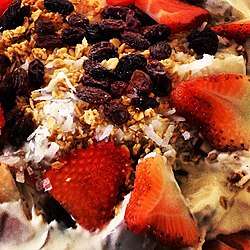
Mexico's candy and bakery sweets industry, centered in Michoacán and Mexico City, produces a wide array of products.
- Alegrías
- Alfajor
- Amaranto
- Arroz con leche, rice pudding
- Bionico, a type of fruit salad with cream
- Buñuelos
- Cajeta
- Calavera
- Capirotada
- Carlota de limón
- Champurrado
- Chongos zamoranos, a milk candy named for its place of origin, Zamora, Michoacán.
- Chocolate
- Churros
- Cocadas
- Cochinito de Piloncillo
- Coyotas
- Crepas de cajeta
- Dulce de leche
- Empanadas
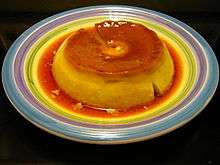
- Flan
- Fresas con crema
- Gelatina
- Glorias
- Gorditas de azucar
- Ice cream ("nieves" and "helados"). Pancho Villa was noted as a devotee of ice cream. The Mexican ice cream industry is centered in the state of Michoacán; most ice cream stands in Mexico are dubbed La Michoacana as a tribute to Michoacán's acknowledged leadership in the production of this product.
- Jamoncillos
- Jarritos (spicy tamarindo candy in a tiny pot), as well as a brand of soda
- Macarrones de dulce de leche
- Mazapán de Cacahuate
- Nicuatole
- Obleas
- Paletas, popsicles (or ice lollies), the street popsicle vendor is a noted fixture of Mexico's urban landscape.
- Pan de Acambaro (Acambaro bread), named for its town of origin, Acambaro, Guanajuato. Very similar to Jewish Challah bread, which may have inspired its creation.
- Pan de muerto, sugar covered pieces of bread traditionally eaten at the Día de muertos festivity.
- Pan de nata
- Pan dulce, sweet pastries in many shapes and sizes that are very popular for breakfast. Nearly every Mexican town has a bakery (panaderia) where these can purchased.
- Pastel de queso, cheesecake
- Pastel de tres leches (Three Milk Cake)
- Pepitorias
- Platano
- Plátano frito
- Polvorón
- Rosca de reyes
- Tacuarines, Biscochos, or Coricos
Beverages
Non-alcoholic
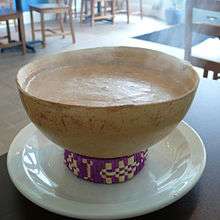
- Aguas frescas
- Atole
- Café de olla, coffee with cinnamon
- Chamoyada
- Champurrado
- Chia Fresca
- Chocolate, generally known better as a drink rather than a candy or sweet
- Horchata
- Jamaica (drink)
- Jarritos (drink)
- Jugos frescos
- Lechuguilla
- Licuado, a drink that includes banana, chocolate, and sugar
- Mangonada
- Mexican Coke
- Mexican tea culture
- Pópo
- Pozol
- Tamarindo
- Tejate
Alcoholic
See also
- List of cuisines
- List of maize dishes
- List of tortilla-based dishes
- Mexican breads
- Mexican street food
- New Mexican cuisine
- Sopaipilla (not typical in Mexico, but common in New Mexico)
- Tex-Mex
References
- ↑ "Menu in Progress: Anatomy of an Oaxacan Carniceria". Retrieved 1 June 2017.
External links
| Wikimedia Commons has media related to Cuisine of Mexico. |
| Wikibooks Cookbook has a recipe/module on |
- Mexican Cuisine at Curlie (based on DMOZ)



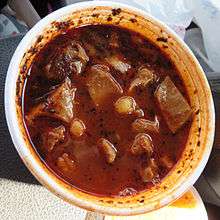
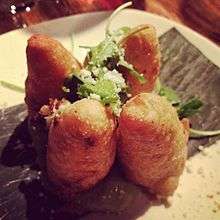
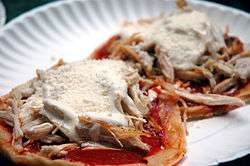



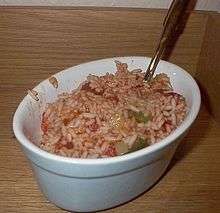
%2C_chicken%2C_avocado%2C_corn.jpg)
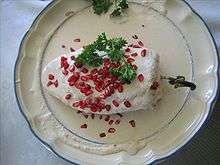
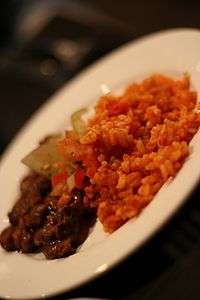
.jpg)